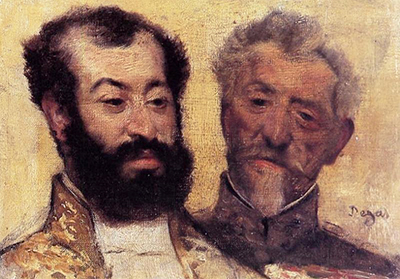Many art critics often compare the work of Edgar Degas to other Impressionism artists such as Pierre-Auguste Renoir and Claude Monet.
The portrait of both the general and chief belongs to an array of portraits Edgar Degas often completed. Some of these include Woman Seated At A Balcony, Elena Carafa, and Madame De Rutte. Yet, none of these pieces are remarked as famous art pieces by Degas. Rather, the artist's deep love for showcasing the beauty of ballet is what he is often regarded for. Some of these most famous pieces include Ballet Class, Dance Class, and Blue Dancers. Edgar Degas was also immensely pulled towards the nude female body in which he created a collection of pastel pieces early in his career. Some of these classic pieces include The Bath, The Tub, and The Toilette. Once in a while, Degas created a few portraits throughout his career. As he was trained in a realist viewpoint, it was quite easy for him to create portraits of those around him. Yet, as the forefather of Impressionism, he was also immensely in tune with adding a new element into his work. These different styles distinguished his artwork from realism and rather the new art movement of Impressionism.
The portrait of the General and the Chief is quite captivating. While the feel of the work initially feels like pastel on paper, rather it's oil on canvas. It's difficult to exactly conclude which individual is which, but many art credits believe that the man on the left is General Mellinet. The man stands slightly turned away from the viewer, as he looks out into the unknown. His closed mouth is covered by a large black beard. Yet, his plump lips make their way to the viewer to notice. The man's nose is incredibly pointy and slightly long. His oval eyes are painted all black, with no glimpse of white. The General's eyebrows are slightly arched in a thick black colour. All of these facial elements come together creating an intimidating face. The man's hair is slightly dwindling near the sides, causing for the front part to only remain. The General is dressed in a stunning gold jacket with lively detailing. Beneath is a white undershirt that covers his body.
The Chief on the other hand is painted with a different perspective. His body is placed in the centre as he looks onto the viewer. He has a small greying beard alongside a moustache. His skin is more tanned, with greater contoured characteristics. Degas most likely created this greater shade on the man's face to convey his age. The man too is balding at the sides as his grey hair sticks upwards. His nose is much more prominent and looks towards the viewer. His deep eye bags fill his face, adding more description to him. Degas uses a lighter colour on his forehead that creates an even greater contrast in comparison to the rest of his skin.
Finally, the man is dressed in a similar army coat that is closed at his neck. As his attire is greatly shaded, it seems as if it's in the same design as the General, yet in a red shade. The Chiefs body is slightly hidden by the General. Yet, his presence is not overpowered as it is he who looks directly at the viewer. Degas sticks to the warm colour scheme throughout the piece and colours the back walls in a yellow creamy texture. Glimpse of gold jump onto the canvas, yet the work is much more focused on accentuating the men. It is unknown if this piece was gifted to the men, purchased, or simply a painting Degas kept for himself.




